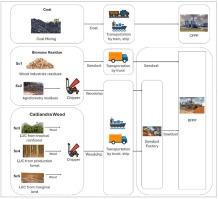生命周期温室气体排放评估:将提前退役的燃煤发电厂改造为生物质发电厂
IF 5.9
Q2 ENERGY & FUELS
引用次数: 0
摘要
拆除老化的燃煤发电厂 (CFPP) 是减少温室气体 (GHG) 排放、加快能源结构多样化、实现国家确定的贡献和净零排放目标的有效战略。然而,拆除 CFPP 并建设一座容量与拆除的 CFPP 相当的可再生能源发电厂可能会给国家财政造成负担。因此,在老化的 CFPP 中将煤炭转换为 100% 的生物质燃料是需要研究的建议之一。本研究对生命周期温室气体(LC GHG)排放进行了环境评估,包括原材料提取和发电厂运行。共分析了五种方案。两个方案涉及在老化的 CFPP 中使用锯末和农林残渣作为生物质燃料。其他三个方案使用从热带森林、生产林和贫瘠土地上采伐的 Calliandra 木材作为生物质燃料,这产生了土地利用变化 (LUC) 带来的温室气体排放。这项研究表明,与煤炭相比,锯末和农林业残留物可以减少对全球变暖的影响。碳储量较高的土地利用变化会增加对全球变暖的影响,而碳储量较低的土地利用变化则会减少对全球变暖的影响。当煤炭转化为 100% 生物质时,老化 CFPP 效率的降低将导致全球变暖影响的增加。本文章由计算机程序翻译,如有差异,请以英文原文为准。

Life cycle greenhouse gas emissions assessment: converting an early retirement coal-fired power plant to a biomass power plant
Decommissioning aging coal-fired power plants (CFPPs) represents an effective strategy for reducing greenhouse gas (GHG) emissions, accelerating energy mix diversification, and achieving nationally determined contributions and net-zero emissions targets. However, dismantling the CFPP and building a renewable energy-based power plant with a capacity equal to a dismantled CFPP could burden state finances. Therefore, converting coal to 100% biomass fuel in the aging CFPP is one of the proposals that needs to be studied. This study conducted an environmental assessment concerning the Life Cycle Greenhouse Gas (LC GHG) emissions, encompassing raw material extraction and power plant operation. Five scenarios were analyzed. Two scenarios related to using sawdust and agroforestry residue for biomass fuel in the aging CFPP. The other three scenarios used biomass fuel from Calliandra wood harvested from tropical forests, production forests, and marginal land, which produced GHG emissions from Land Use Change (LUC). This study demonstrates that sawdust and agroforestry residue can reduce global warming impacts compared to coal. The LUC in higher carbon stock land will increase global warming impacts, while the LUC in lower carbon stock land will reduce global warming impacts. A decrease in the aging CFPP efficiency, when coal is converted to 100% biomass, will cause an increase in global warming impacts.
求助全文
通过发布文献求助,成功后即可免费获取论文全文。
去求助
来源期刊

Renewable Energy Focus
Renewable Energy, Sustainability and the Environment
CiteScore
7.10
自引率
8.30%
发文量
0
审稿时长
48 days
 求助内容:
求助内容: 应助结果提醒方式:
应助结果提醒方式:


